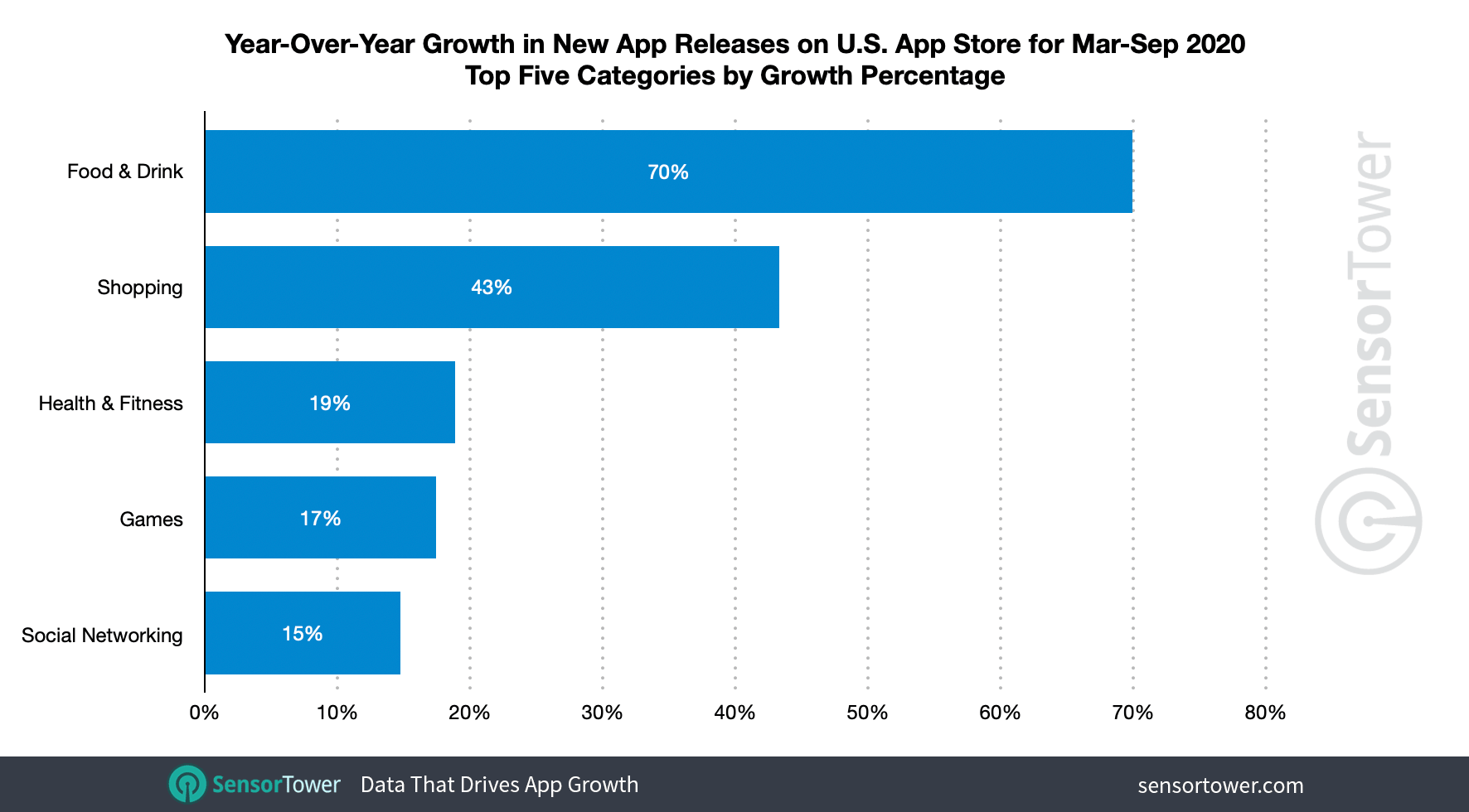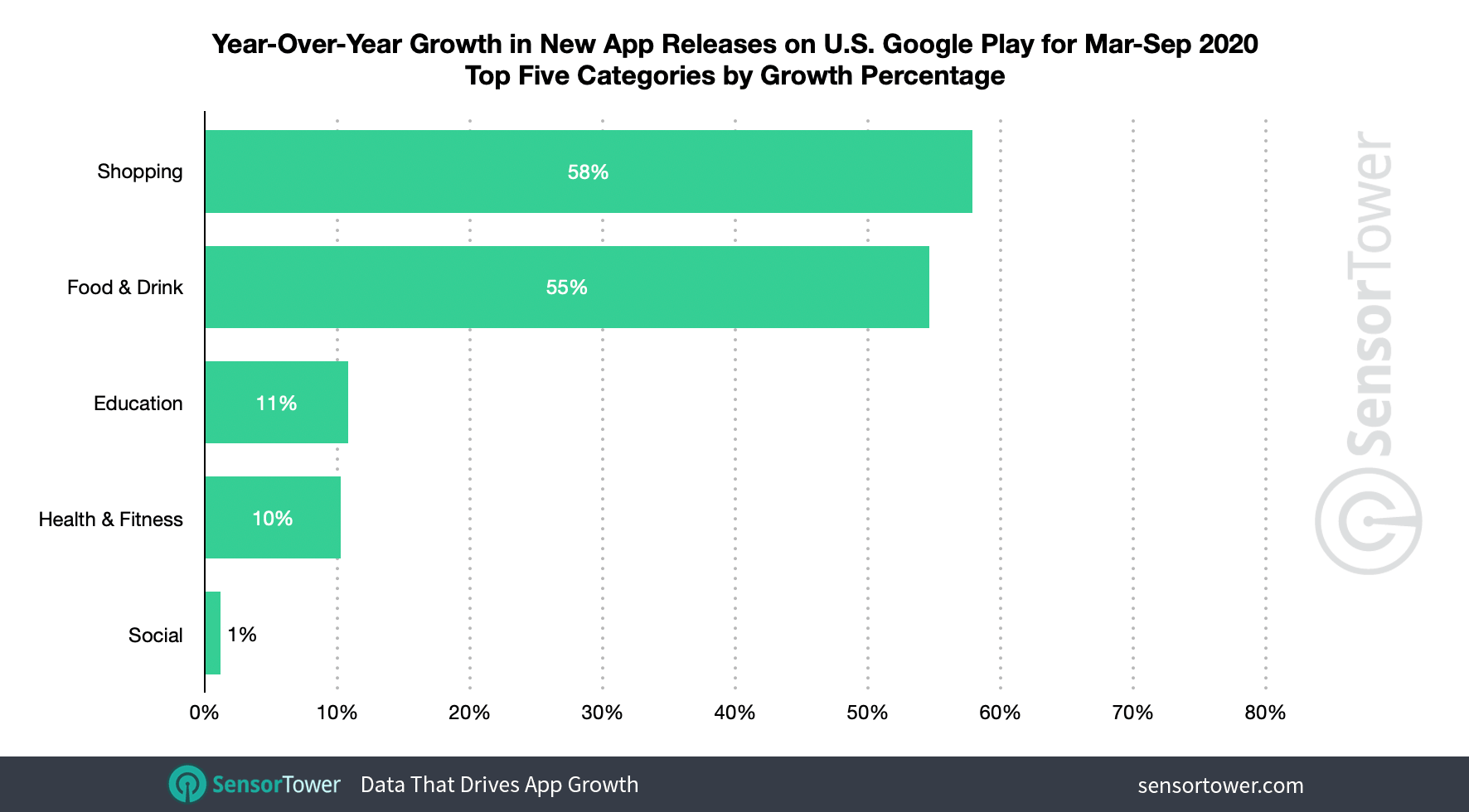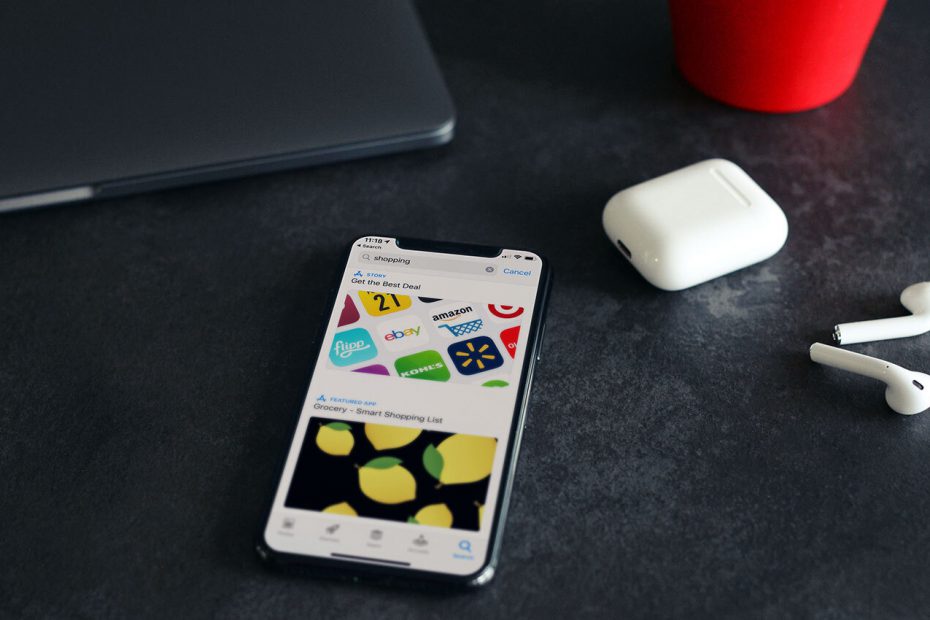
While COVID-19 has adversely affected the growth of app store categories such as Travel and Photo & Video, others have flourished as consumer behavior has shifted amid the pandemic. This is most evident in the Shopping and Food & Drink categories, where Sensor Tower App Intelligence data shows new app releases have grown 52 and 60 percent year-over-year, respectively, across the U.S. app stores since shelter-in-place orders were widely enacted in March 2020.
This growth exceeds what these categories experienced in 2019. Between March and September 2019, about 13 percent fewer Food & Drink apps launched in the U.S. when compared to the same period in 2018. Shopping app releases experienced growth of close to 7 percent Y/Y between the same periods.
New Apps on Apple’s App Store
The overall number of new apps and games on Apple’s U.S. App Store grew by nearly 2 percent Y/Y for the March to September period. This was 3 percentage points greater than the 1 percent decrease seen when comparing the same period between 2018 and 2019.
The Food & Drink category saw the greatest increase in new app launches during the March to September period on Apple’s platform, growing nearly 70 percent Y/Y. The Shopping category displayed the second greatest increase, up approximately 43 percent Y/Y. Health & Fitness was the third highest-growth category, with new app releases climbing nearly 19 percent Y/Y.

The Y/Y growth of these categories for this period in 2020 far exceeds what they saw during the same period in 2019. Food & Drink saw an 11 percent decrease in apps launched between March to September 2019 when compared to the same period in 2018, and Shopping app releases grew only 11 percent Y/Y in the 2019 period. The number of Health & Fitness apps launched in the 2019 period was only 1 percent higher than the year before.
Growth aside, the five categories that saw the largest number of new apps launched between March and September 2020 were Games, Utilities, Business, Lifestyle, and Education.
New Apps on Google Play
Although the overall number of new apps released between March and September in the U.S. was greater on Google’s platform than the App Store, fewer were launched on the Play store this year than during the same period in 2019. The number of new apps released on Google Play fell nearly 12 percent Y/Y from the same period in 2019. This continued the trend from the previous year, which saw around 8 percent fewer apps launch when compared to the same period in 2018.

The Shopping category experienced the most Y/Y growth on Google Play, climbing nearly 58 percent in the U.S. It was closely followed by Food & Drink, which grew nearly 55 percent. Although Education trailed the other two categories with 11 percent Y/Y growth, it saw the largest number of new apps launched in the period on the platform.
After Education, the Google Play categories that added the most new apps since March were Entertainment, Music & Audio, Tools, and Books & Reference.
Lockdown App Trends
The top Shopping and Food & Drink apps launched on the U.S. App Store between March and September mainly cater to new social-distancing norms. The Shopping category saw launches from big brands such as the Big Lots app as well as from local boutiques, offering delivery and in-store pickup options.
Many of the new apps in Shopping appear positioned to appeal to budget-conscious consumers with an interest in coupons and flash deals. Fast fashion apps aim to tap into the success of Shein, which has reached nearly 12.3 million installs this year in the U.S. alone. A subset are B2B fashion import companies that are geared toward small business owners looking for discounted wholesale merchandise.
Others target specific niches; two of the top 10 new Shopping apps were Advance Auto Parts and FIGS, which appeal to the uptick in consumers who may be buying or selling used cars and providing a mobile option for healthcare workers who are looking to purchase medical scrubs, respectively.

The majority of the new Food & Drink apps focused on delivery or order-ahead features. Campus food apps Transact Mobile Ordering and Bite by Sodexo specifically offer contact-free ordering and payment for college students. And, perhaps taking a cue from the success of alcohol delivery apps during shelter-in-place orders such as Drizly, Texas beverage chain Spec launched Spec’s Wine Liquor & Beer to provide consumers with a way to order from an app. A subset was geared toward home cooking by offering recipes for specific lifestyles, such as vegan or keto diets, or for convenient meal preparation using products like the Instant Pot.

As in the Shopping category, Food & Drink saw launches from national brands as well as smaller local restaurants. A number of imitators have also sprung up across both platforms that pose as the official delivery or coupon app of national fast food chains such as Popeyes, KFC, Pizza Hut, Chipotle, and more. These developers clearly aim to tap into consumer demand for access to food delivery services from recognizable brands.
New Apps Deliver More Options
Both national brands and small business owners are adapting to the shifts in consumer behavior during the COVID-19 pandemic by turning to apps. The new launches in the Food & Drink and Shopping categories largely aim to streamline orders, minimize human interaction, and provide discounts to consumers who may have been hit by the recession. While these businesses are currently motivated to provide contact-free payment and ordering due to the ongoing health crisis, it will be interesting to see how they continue to develop and leverage mobile apps in the future.
Note: App launches include all apps that ranked at least once on the U.S. App Store or Google Play during the periods studied.
Sensor Tower’s App Intelligence platform is an Enterprise level offering. Interested in learning more?

